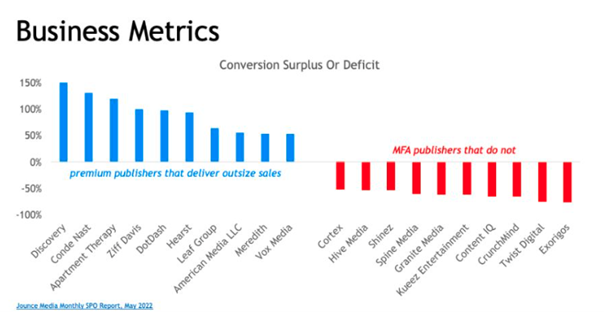
In June 2023, MediaSense experts first wrote about the practical steps advertisers should take to avoid Made for Advertising (MFA) websites, following the release of the first part of the ANA programmatic media supply chain transparency study.
The report found that MFA sites represented 21% of impressions and 15% of programmatic media spend.
Much has been written about MFAs recently – Marie Peters summarises the latest and most important take-homes for advertisers.
June 2023 – May 2024
- The second and final part of the ANA’s transparency report was released in December 2023 and suggested that 25% of programmatic spend is wasted; a vast proportion of this on MFA sites
- An Adalytics report at the start of 2024, found hundreds of examples of large brands advertising on MFA sites, facilitated by a multitude of ad platforms
- A subsequent Adalytics report published findings that Forbes – a legitimate, premium publisher – had been using an MFA style subdomain purely to garner programmatic, open web advertising inventory, prompting advertisers and their agencies to review log-level data and demand refunds for impressions served
Why MediaSense Advises Advertisers to Take Measures to Exclude MFA Sites
- MFA sites are built to ‘game’ standard delivery metrics. They often report low cost and high viewability, but they host a high density of ads and ad placements, and therefore a reduced opportunity to gain user attention
- They contain lower quality and less relevant content – which is often machine-generated – and they attract traffic via a combination of questionable, non-organic tactics including clickbait headlines, interlinked websites and articles split across multiple pages purely to increase ad volume, which can only be a negative for brand suitability and brand salience
- A high volume of ads around poor-quality content provides a poor user experience, meaning ad spend is wasted on ineffective placements and media performance is negatively impacted
- In addition to media performance concerns, there are considerations around responsible media buying such as the impact on carbon emissions – according to Scope3 MFA sites result in higher carbon emissions than non-MFA sites due to the high number of ad calls for every web page. Plus, the fact that every £$ spent on an MFA site is a £$ that could have been invested with a legitimate publisher who is creating original content and providing the benefits of quality journalism
Jounce has previously shared results of a study showing premium publishers deliver greater media performance outcomes than MFA publishers.
MFA sites are at least 50% less likely to drive a conversion:

Solving the MFA Challenge
MFA sites are a difficult problem to solve, with multiple parties in the media supply chain and new technologies coming to the forefront as a means to monitor & eliminate MFA spend only adds to the ever -growing roster of digital suppliers.
Whilst there is now a widely agreed definition of what constitutes a MFA it’s still not a simple ‘yes’ or ‘no’ but a combination of characteristics for which there’s no defined threshold. Legitimate publishers and websites are at times demonstrating some of these characteristics – such as a high ad-to-content ratio and ad formats that ‘follow’ the viewer – to deliver against existing metrics of success like viewability and capture media budgets in the open market. This blurs the lines between an MFA website built specifically to fraudulently capture ad spends Vs inventory sold by established media owners.
Existing metrics such as viewability alone are not effective for distinguishing ‘premium’ publishers from everyone else.
Recommended Actions for Advertisers:
- Refine and define the display & video inventory you are willing to buy. Working closely with fewer partners in the supply path, increasing direct buys with premium publishers and using inclusion lists will ensure ads are only served on domains that publish quality content and are proven to be actively visited by humans
- Demand full transparency from agencies and ad platforms on where impressions have been delivered. Utilise technology in the market to review domain-level data and identify any potential MFA sites but ensure this is supplemented with a manual review Vs your inclusion list. Continue to refine or expand the inclusion list and trading relationships
- Expand media evaluation metrics from only hygiene metrics such as viewability and brand safety to a new model that incentivises the right behaviours with your agency and media partners through the prioritisation of media quality. Developing a bespoke strategy for optimising campaigns to factors such as ad size & position (premium formats), contextually relevant placements and premium content, audible %, time in view or engagement, will ensure media delivers maximum impact and improved performance
To discuss MFA best practice and optimising your media impact, talk to our team.